
Daisy Duck is an American cartoon character created by the Walt Disney Company. As the girlfriend of Donald Duck, she is an anthropomorphic white duck that has large eyelashes and ruffled tail feathers around her lowest region to suggest a skirt. She is often seen wearing a hair bow, blouse, and heeled shoes. Daisy was introduced in the short film Mr. Duck Steps Out (1940) and was incorporated into Donald's comic stories several months later. Carl Barks, the screenwriter and lead storyboard artist for the film, was inspired by the 1937 short, Don Donald, that featured a Latin character named Donna Duck, to revive the concept of a female counterpart for Donald.
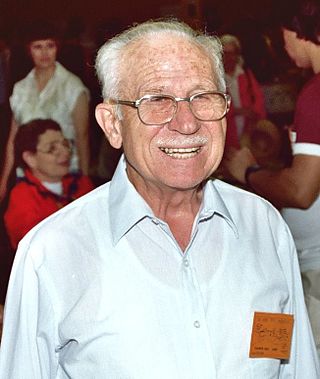
Clarence Charles "Ducky" Nash was an American voice actor and impressionist. He is best remembered as the original voice of the Disney cartoon character Donald Duck. He was born in the rural community of Watonga, Oklahoma, and a street in that town is named in his honor. In 1993, he was posthumously made a Disney Legend for his contributions to Walt Disney films.

Trick or Treat is a 1952 animated short film produced by Walt Disney Productions and released by RKO Radio Pictures. The cartoon, which takes place on Halloween night, follows a series of pranks between Donald Duck and his nephews with Witch Hazel. The film was directed by Jack Hannah and features the voices of Clarence Nash as Donald and his nephews, and June Foray as Hazel.

Mr. Duck Steps Out is a Donald Duck cartoon produced by Walt Disney Productions, which is released on June 7, 1940, and featured the debut of Daisy Duck. The short was directed by Jack King and written by Carl Barks, Chuck Couch, Jack Hannah, Harry Reeves, Milt Schaffer, and Frank Tashlin.
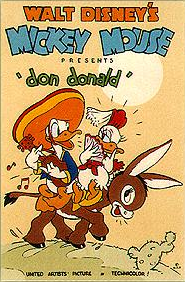
Don Donald is a 1937 American animated short film produced by Walt Disney Productions and released by United Artists. The cartoon follows Donald Duck attempting to woo a female Mexican duck named Donna. It was directed by Ben Sharpsteen and features music by Paul J. Smith which was adapted from the Mexican folk songs "Cielito Lindo" and "Jarabe Tapatío". Clarence Nash voiced both Donald and Donna.

Donald's Ostrich is an animated short film produced in Technicolor by Walt Disney Productions and released to theaters on December 10, 1937, by RKO Radio Pictures. It was the first film in the Donald Duck series of short films, although billed at the time as a Mickey Mouse cartoon. It was the first of the series to be released by RKO.

Self Control is an animated short film in the Donald Duck series, produced in Technicolor by Walt Disney Productions and released to theaters on February 11, 1938, by RKO Radio Pictures. The film follows Donald trying to learn to control his temper by following the advice of a radio program.

A Good Time for a Dime is a 1941 Disney short film in which Donald Duck watches a risqué Daisy perform the "Dance of the Seven Veils" in a Mutoscope at a penny arcade nickelodeon peep show. Donald also struggles with a crane drop machine and a miniature airplane ride.
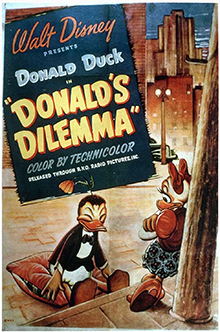
Donald's Dilemma is a Walt Disney Studios animated cartoon directed by Jack King and starring Donald and Daisy Duck. It was originally released on July 11, 1947 in the United States. The title of this short is somewhat of a misnomer. Although Donald is the official headliner for this cartoon, Daisy is the actual protagonist. The dilemma of the title is actually offered to her, not to Donald.
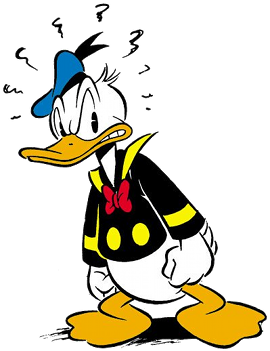
Donald Duck is a cartoon character created by The Walt Disney Company. Donald is an anthropomorphic white duck with a yellow-orange bill, legs, and feet. He typically wears a sailor shirt and cap with a bow tie. Donald is known for his semi-intelligible speech and his mischievous, temperamental, and pompous personality. Along with his friend Mickey Mouse, Donald was included in TV Guide's list of the 50 greatest cartoon characters of all time in 2002, and has earned a star on the Hollywood Walk of Fame. He has appeared in more films than any other Disney character.
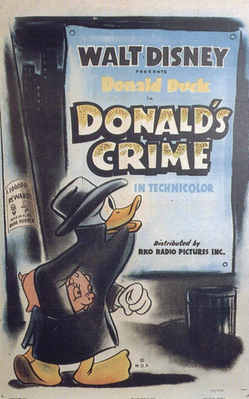
Donald's Crime is a 1945 American animated short film produced by Walt Disney Productions and released by RKO Radio Pictures. The cartoon, which parodies film noir crime dramas of the time, follows Donald Duck as he struggles with guilt after stealing $1.25 from his nephews. The film was directed by Jack King and features original music by Edward H. Plumb. The voice cast includes Clarence Nash as Donald, Huey, Dewey, and Louie, Ruth Clifford as Daisy Duck, and Harry E. Lang as the off-stage voice of Donald's conscience. This was Blondell's first performance as Daisy and marks the debut of the character's "normal" voice. Previously in Mr. Duck Steps Out, Daisy had been voiced by Nash using a voice similar to Donald's.
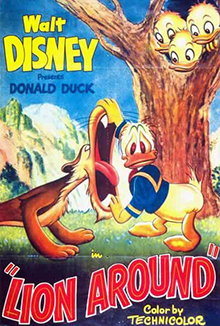
Lion Around is a 1950 Donald Duck cartoon featuring Donald Duck, his nephews Huey, Dewey, and Louie and Louie the Mountain Lion. The film is the first appearance of Louie the Mountain Lion. In this episode, Donald is tricked into thinking he is getting attacked by a cougar.

The Clock Watcher is a 1945 American animated short film produced by Walt Disney Productions and released by RKO Radio Pictures. The cartoon follows Donald Duck as he works at the Royal Bros. department store, where he goofs off by breaking gifts and wrapping them poorly.

Window Cleaners is an animated short film produced in Technicolor by Walt Disney Productions and released to theaters on September 20, 1940 by RKO Radio Pictures.

The Eyes Have It is a Donald Duck animated short film produced in Technicolor by Walt Disney Productions, originally released on March 30, 1945 by RKO Radio Pictures. It was the final Disney short animated by Don Patterson and it was the only short to have his on-screen credit. The last Donald Duck cartoon to feature Pluto, it centers on Donald using hypnosis goggles to turn Pluto into various animal-like states.

Sleepy Time Donald is a Donald Duck animated short film which was released on May 9, 1947, and produced in Technicolor by RKO Radio Pictures. It was the sixth cartoon in Donald's filmography to feature Daisy Duck.
Donald's Double Trouble is a 1946 Donald Duck short film released by RKO Radio Pictures, colored by Technicolor and produced by Walt Disney Productions. This cartoon marks the fourth appearance of Daisy Duck.
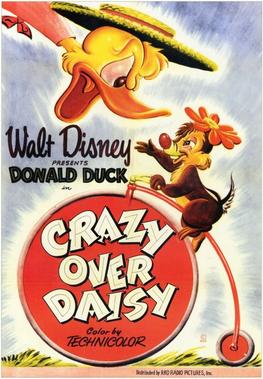
Crazy Over Daisy is a Donald Duck animated short film which was originally released on March 18, 1950. Produced by Technicolor by Walt Disney Productions and RKO Radio Pictures, the short featured Donald Duck, Daisy Duck, and Chip n' Dale. Mickey Mouse, Minnie Mouse, and Goofy also made a brief cameo at the beginning of the film. The story takes place in the 1890s. Donald is on his way to visit Daisy, when Chip n' Dale come along and spoil the date.

Donald's Diary is a Donald Duck short film which was produced in Technicolor and released February 13, 1954 by RKO Radio Pictures.

Donald's Dream Voice is a 1948 American animated short film featuring Donald Duck, the film was directed by Jack Hannah and produced by Walt Disney. In the short film, no one understands a word that salesman Donald says, so he takes voice pills to improve his speech.



















